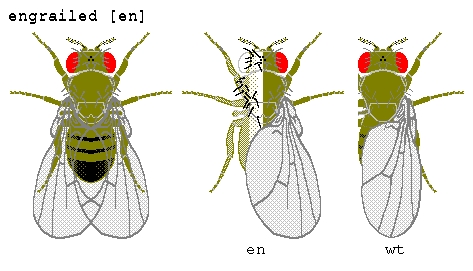

ENGRAILED [en]
Lindsley & Grell, 1972, pp. 86-87
location: 2-62.0.
origin: Spontaneous.
discoverer: Evang, 26k7.
references: Eker, 1929, Hereditas 12: 217-22 (fig.). Bridges, Skoog, and Li, 1936, Genetics 21: 788-95. Brasted, 1941, Genetics 26: 347-73 (fig.).
phenotype: Longitudinal cleft extends from rear border of scutellum forward; may be reduced to median nick or posterior flattening of scutellum. Bristles often javelin- or hooked-like. Wings larger, broader, and thin textured, with spatulate end; venation always disturbed (like that of ci), with gap in L4 and L5 and branching plexus of extra veins. In males, extra sex comb often present, smaller than normal and in mirror-image position on outer side of tarsus. Action of en on differentiation of secondary sex comb on male foreleg is autonomous [Tokunaga, 1961, Genetics 46: 157-76 (fig.)]. Male genitalia may be malformed and rotated, resulting in sterility (Curry, 1941, DIS 14: 50). cg en/++ characterized by slight degree of L4 interruption and thinning in males at low temperature. The triple heterozygote cg en/++; ci/+ has about 50 percent expression of L4 interruption (House, 1961, Genetics 46: 871). For other interactions of en with ci alleles and H, see House (1953, Genetics 38: 199-215, 309-27). RK1.
color figure: P. A. Otto (original)
b & w figure: Eker, 1929, Hereditas 12: 217-22.

